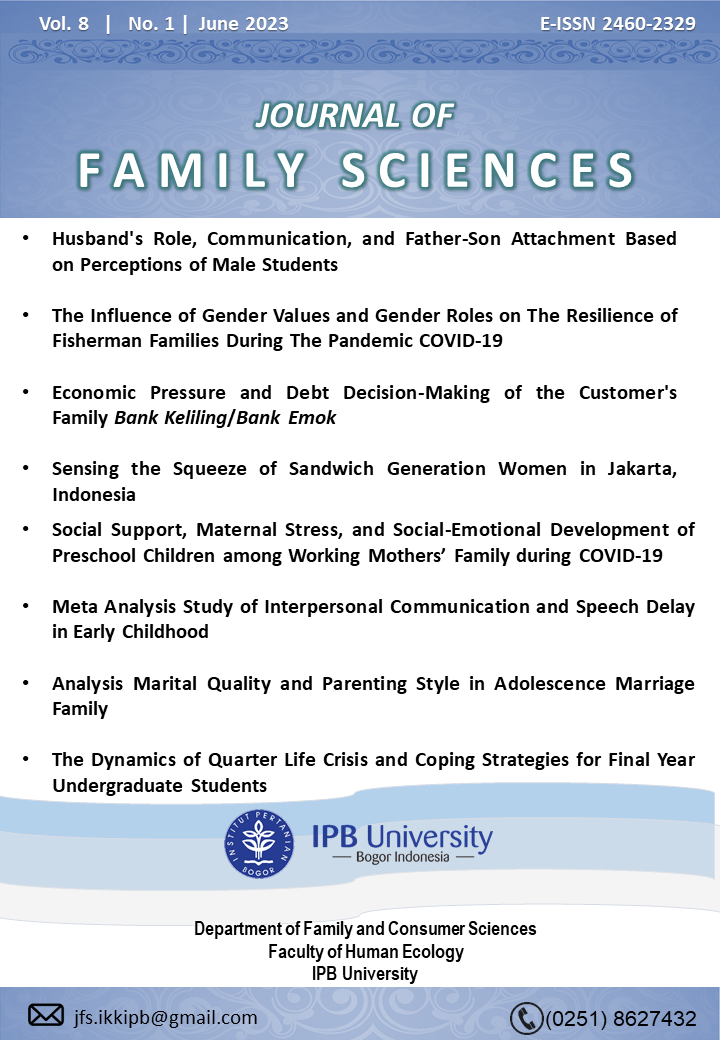Husband's Role, Communication, and Father-Son Attachment Based on Perceptions of Male Students
Husband's Role, Communication, and Father-Son Attachment Based on Perceptions of Male Students
Abstract
Boys perceive the role of a father based on what he sees, namely the role of their father in the family. This study aimed to identify communication, father-son attachment, and husband's role based on student perceptions. Sixty male IPB students from villages and cities were respondents in this study. Based on the results of the study, it was found that there was no difference in communication, father-son attachment, and the perception of the husband's role between students from urban and rural areas. Therefore, the level of communication is in the medium category, attachment is in the safe category, and the perception of the husband's role is in the medium category. Based on the regression test, it is known that father-son communication has a significant positive effect on the perception of the husband's role. So, the higher the communication between father and son, the better the perception of the husband's role in the division of tasks, openness with partners, accountability for the use of resources, and agreement on achieving family goals. The theoretical implication of this research is to prove that father-son communication affects sons' perceptions of the father's role; in practice, good father-son communication makes boys open with their partners, take responsibility, and share household chores.
Downloads
References
[BPS] Badan Pusat Statistik Indonesia. (2022). Statistik Indonesia 2022 (Katalog 11). Retrieved from https://www.bps.go.id/publication/2020/04/29/e9011b3155d45d70823c141f/statistik-indonesia-2020.html
Ackard, D. M., Neumark-Sztainer, D., Story, M., & Perry, C. (2006). Parent-child connectedness and behavioral and emotional health among adolescents. American Journal of Preventive Medicine, 30(1), 59–66. doi: 10.1016/j.amepre.2005.09.013
Adhim, F. (2002). Indahnya pernikahan dini. Yogyakarta(ID): Gema Insani.
Armsden, G. C., & Greenberg, M. T. (1987). The inventory of parent and peer attachment: Individual differences and their relationship to psychological well-being in adolescence. Journal of Youth and Adolescence, 16(5), 427–454.
Barnett, R. C., Marshall, N. L., & Pleck, J. H. (1992). Men’s multiple roles and their relationship to men’s psychological distress. Journal of Marriage and Family, 54(2), 358–367. Retrieved from https://www.jstor.org/stable/353067?seq=1#metadata_info_tab_contents
Burnod, L., Patterson, K., Dickinson, K., & Coveney, J. (2022). Sharing the load: A qualitative exploration of what mothers and fathers believe the father’s role should be in food provisioning. Appetite, 176, 106101. doi: 10.1016/j.appet.2022.106101
Carlson, D. S. (1999). Personality and role variables as predictors of three forms of work–family conflict. Journal of Vocational Behavior, 55(2), 236–253. doi: 10.1006/jvbe.1999.1680
Chatoor, I., Sechi, C., Vismara, L., & Lucarelli, L. (2022). A cross-sectional study of father-daughter/son interactions from 1 Month to 3 years of age with the feeding and play scales: Exploring the psychometric properties. Appetite, 168, 1–10. doi: 10.1016/j.appet.2021.105671
Cooley, M. E., & Petren, R. E. (2020). A qualitative examination of coparenting among foster parent dyads. Children and Youth Services Review, 110, 1–9. doi: 10.1016/j.childyouth.2020.104776
Damayanti, Y. (2014). Hubungan persepsi remaja laki-laki terhadap peran ayah dengan kenakalan remaja di SMK Sukawati Sragen (Universitas Negeri Semarang). Retrieved from https://lib.unnes.ac.id/23573/
Datta, K. (2007). “In the eyes of a child, a father is everything”: Changing constructions of fatherhood in urban Botswana? Women’s Studies International Forum, 30(March), 97–113. doi: 10.1016/j.wsif.2007.01.005
David, M., Daharnis, D., & Said, A. (2014). Persepsi anak terhadap peran ayah dalam keluarga dan implikasinya terhadap pelayanan bimbingan dan konseling. Jurnal Konseling dan Pendidikan, 2(1), 25–29. doi: 10.29210/111600
Elia, H. (2000). Peran ayah dalam mendidik anak. Jurnal Veritas, 1(1), 105–113. doi: 10.36421/veritas.v1i1.23
Firdanianty, Lubis, D. P., Puspitawati, H., & Susanto, D. (2016). Komunikasi remaja dengan ayah masih minim: Studi pada siswa SMA di Kota Bogor. Jurnal Ilmu Keluarga & Konsumen, 9(2), 124–135. doi: 10.24156/jikk.2016.9.2.124
Gabie, A., & Santosa, E. M. (2003). Dinamika pengambilan keputusan mahasiswa pindah jurusan di lingkungan Unika Atma Jaya. Universitas Kristen Atma Jaya.
Goldberg, A. E., McCormick, N., Frost, R., & Moyer, A. (2021). Reconciling realities, adapting expectations, and reframing “success”: Adoptive parents respond to their children’s academic interests, challenges, and achievement. Children and Youth Services Review, 120, 1–14. doi: 10.1016/j.childyouth.2020.105790
Grady, W. R., Tanfer, K., Billy, J. O. G., & Lincoln-Hanson, J. (1996). Men’s perceptions of their roles and responsibilities regarding sex, contraception and childrearing. Family Planning Perspectives, 28(5), 221–226. doi: 10.2307/2135841
Gullone, E., & Robinson, K. (2005). The inventory of parent and peer attachment - revised (IPPA-R) for children: A psychometric investigation. Clinical Psychology and Psychotherapy, 12(1), 67–79. doi: 10.1002/cpp.433
Gunarsa, S. D. (2008). Psikologi Perawatan. Jakarta(ID): Gunung Mulia.
Gur, A., & Hindi, T. N. (2022). Exploring fathers’ perspectives on family-centered services for families of children with disabilities. Research in Developmental Disabilities, 124, 104199. doi: 10.1016/j.ridd.2022.104199
Hanum, N. (2017). Analisis pengaruh pendapatan terhadap perilaku konsumsi mahasiswa Universitas Samudra di Kota Langsa. Jurnal Samudra Ekonomika, 11(2), 107–116. Retrieved from 10.1234/jse.v1i2.325
Hazzard, V. M., Miller, A. L., Bauer, K. W., Mukherjee, B., & Sonneville, K. R. (2020). Mother–child and father–child connectedness in adolescence and disordered eating symptoms in young adulthood. Journal of Adolescent Health, 66(3), 366–371. doi: 10.1016/j.jadohealth.2019.09.019
Hengst, J. A. (2015). Distributed communication: Implications of cultural-historical activity theory (CHAT) for communication disorders. Journal of Communication Disorders, 57, 16–28. doi: 10.1016/j.jcomdis.2015.09.001
Hong, J. S., Valido, A., Espelage, D. L., Lee, S. J., DeLara, E. W., & Lee, J. M. (2021). Adolescent bullying victimization and psychosomatic symptoms: Can relationship quality with fathers buffer this association? Journal of Affective Disorders, 295, 1387–1397. doi: 10.1016/j.jad.2021.09.013
Imsa, M. A. (2017). Pengaruh komunikasi dan kelekatan orang tua-remaja terhadap kontrol diri remaja (kasus tahanan anak di LPKA/rutan) [skripsi]. Departemen Ilmu Keluarga dan Konsumen, IPB University, Bogor.
Jansen, E., Harris, H., & Rossi, T. (2020). Fathers’ perceptions of their role in family mealtimes: A Grounded theory study. Journal of Nutrition Education and Behavior, 52(1), 45–54. doi: 10.1016/j.jneb.2019.08.012
Jessee, V., & Adamsons, K. (2018). Father involvement and father–child relationship quality: An intergenerational perspective. Parenting, 18(1), 28–44. doi: 10.1080/15295192.2018.1405700
Jethwani, M., Mincy, R., & Klempin, S. (2014). I would like them to get where I never got to: Nonresident fathers’ presence in the educational lives of their children. Children and Youth Services Review, 40(May), 51–60. doi: 10.1016/j.childyouth.2014.02.009
Khan, A., & Deb, A. (2021). Family as a source of risk and resilience among adults with a history of childhood adversity. Children and Youth Services Review, 121(September), 1–9. doi: 10.1016/j.childyouth.2020.105897
Khandpur, N., Charles, J., Blaine, R. E., Blake, C., & Davison, K. (2016). Diversity in fathers’ food parenting practices: A qualitative exploration within a heterogeneous sample. Appetite, 101(February), 134–145. doi: 10.1016/j.appet.2016.02.161
King, V., Thorsen, M. L., & Amato, P. R. (2014). Factors associated with positive relationships between stepfathers and adolescent stepchildren. Social Science Research, 47(September), 16–29. Retrieved from 10.1016/j.ssresearch.2014.03.010
Krisnatuti, D., & Oktaviani, V. (2010). Persepsi dan kesiapan menikah. Ilmu Keluarga & Konsumen, 4(1), 30–36. doi: 10.24156/jikk.2011.4.1.30
Krisnatuti, D., & Putri, H. A. (2012). Gaya pengasuhan orang tua, interaksi serta kelekatan ayah-remaja, dan kepuasan ayah. Jurnal Ilmu Keluarga & Konsumen, 5(2), 101–109. doi: 10.24156/jikk.2012.5.2.101
Lestari, G. F., Sukmawati, I., Safitri, N. A., Simanjuntak, M., & Riany, Y. E. (2022). Exploratory study on the moral development of adolescent premarital sex actors. Journal of Family Sciences, Special Ed, 17–36. doi: 10.29244/jfs.vi.36551
Malihah, Z., & Alfiasari, A. (2018). Perilaku cyberbullying pada remaja dan kaitannya dengan kontrol diri dan komunikasi orang tua. Jurnal Ilmu Keluarga & Konsumen, 11(2), 145–156. doi: 10.24156/jikk.2018.11.2.145
Marks, S. R., Huston, T. L., Johnson, E. M., & MacDermid, S. M. (2001). Role balance among white married couples. Journal of Marriage and Family, 63(4), 1083–1098. doi: 10.1111/j.1741-3737.2001.01083.
Maximo, S. I., Tayaban, H. S., Cacdac, G. B., Cacanindin, M. J. A., Pugat, R. J. S., Rivera, M. F., & Lingbawan, M. C. (2011). Parents ’ communication styles and their influence on the adolescents ’ attachment , intimacy and achievement motivation. International Journal of Behavioral Science, 6(1), 60–74. doi: 10.14456/ijbs.2011.5
McBride, B. A., Schoppe, S. J., & Rane, T. R. (2002). Child characteristics, parenting stress, and parental involvement: Fathers versus mothers. Journal of Marriage and Family, 64(4), 998– 1011. doi: 10.1111/j.1741-3737.2002.00998
Mulyana, H., & Kustanti, E. R. (2018). Hubungan antara persepsi terhadap peran ayah dengan pengungkapan diri pada mahasiswa tingkat I. Empati, 7(1), 60–68. Retrieved from https://ejournal3.undip.ac.id/index.php/empati/article/view/20147
Nadhifah, L., Puspitawati, H., & Defina. (2021). Pembagian peran, tingkat interaksi suami-istri serta pengaruhnya terhadap indeks kebahagiaan keluarga petani pada dua masa. Jurnal Ilmu Keluarga Dan Konsumen, 14(2), 116–128. doi: 10.24156/jikk.2021.14.2.116
Oladipo, S. E. (2009). Moral education of the child: Whose responsibility? Journal of Social Sciences, 20(2), 149–156. doi: 10.1080/09718923.2009.11892733
Parmanti, & Purnamasari, S. E. (2015). The role of fathers in children’s upbringing. JURNAL InSight, 17(2), 81–90. doi: 10.26486/psikologi.v17i2
Puspitawati, H. (2017). Gender dan Keluarga: Konsep dan Realita di Indonesia (Revisi). Bogor: IPB Press.
Putri, D. P. K., & Lestari, S. (2015). Pembagian peran dalam rumah tangga pada pasangan suami istri Jawa. Jurnal Penelitian Humaniora, 16(1), 72–85. doi: 10.23917/humaniora.v16i1.1523
Reisz, S., Aviles, A. I., Messina, S., Duschinsky, R., Jacobvitz, D., & Hazen, N. (2019). Fathers’ attachment representations and infant feeding practices. Appetite, 142(July), 1–8. doi: 10.1016/j.appet.2019.104374
Riady, A. S. (2021). Bentuk pembagian peran suami istri pada keluarga di Desa Kromasan, Ngunut, Tulungagung pada masa pandemi Covid-19. Qawwam: Jurnal for Gender Mainstreaming, 15(1), 31–44. doi: 10.20414/qawwam.v15i1.3320
Rizkillah, R., Hastuti, D., & Defina, D. (2023). Pengaruh karakteristik remaja dan keluarga, serta gaya pengasuhan orang tua terhadap kualitas hidup remaja di wilayah pesisir. Jurnal Ilmu Keluarga & Konsumen, 16(1), 37-49. https://doi.org/10.24156/jikk.2023.16.1.37
Rosnati, R., Iafrate, R., & Scabini, E. (2007). Parent-adolescent communication in foster, inter-country adoptive, and biological Italian families: Gender and generational differences. International Journal of Psychology, 42(1), 36–45. doi: 10.1080/00207590500412128
Rosyidah, Z., & Andrias, D. R. (2015). Jumlah uang saku dan kebiasaan melewatkan sarapan berhubungan dengan status gizi lebih anak sekolah dasar. Media Gizi Indonesia, 10(1), 1–6. doi: 10.20473/mgi.v10i1.1-6
Sa’adah. (2019). Peran ganda suami setelah istri menjadi tenaga kerja wanita (TKW) dalam keluarga: Studi sasus di Kalijaga Lombok Timur. Jurnal Humanitas, 5(2), 126–142. doi: DOI: https://doi.org/10.29408/jhm.v5i2.3725
Situmorang, Z. R., Hastuti, D., & Herawati, T. (2016). Pengaruh kelekatan dan komunikasi dengan orang tua terhadap karakter remaja perdesaan. Jurnal Ilmu Keluarga & Konsumen, 9(2), 113–123. doi: 10.24156/jikk.2016.9.2.113
Syibli, Y. M. (2021). Sosok dan peran ayah dalam persepsi anak yatim. JIECO : Journal of Islamic Education Counseling, 1(1), 1–13. doi: 10.54213/jieco.v1i01%20Juni
Williams, S., & Kelly, F. (2005). Relationships among involvement, attachment, and behavioral problems in adolescence: Examining father’s influence. Journal of Early Adolescence, 25(2), 168–196. doi: 10.1177/0272431604274178
Wiswanti, I. U., Kuntoro, I. A., Ar Rizqi, N. P., & Halim, L. (2020). Pola asuh dan budaya: Studi komparatif antara masyarakat urban dan masyarakat rural Indonesia. Jurnal Psikologi Sosial, 18(3), 211–223. doi: 10.7454/jps.2020.21
Authors who publish with this journal agree to the following terms:
- Authors retain copyright and grant the journal right of first publication with the work simultaneously licensed under

This work is licensed under a Creative Commons Attribution 4.0 International License. that allows others to share the work with an acknowledgement of the work's authorship and initial publication in this journal. - Authors are able to enter into separate, additional contractual arrangements for the non-exclusive distribution of the journal's published version of the work (e.g., post it to an institutional repository or publish it in a book), with an acknowledgement of its initial publication in this journal.
- Authors are permitted and encouraged to post their work online (e.g., in institutional repositories or on their website) prior to and during the submission process, as it can lead to productive exchanges, as well as earlier and greater citation of published work (See The Effect of Open Access).



_001.png)



